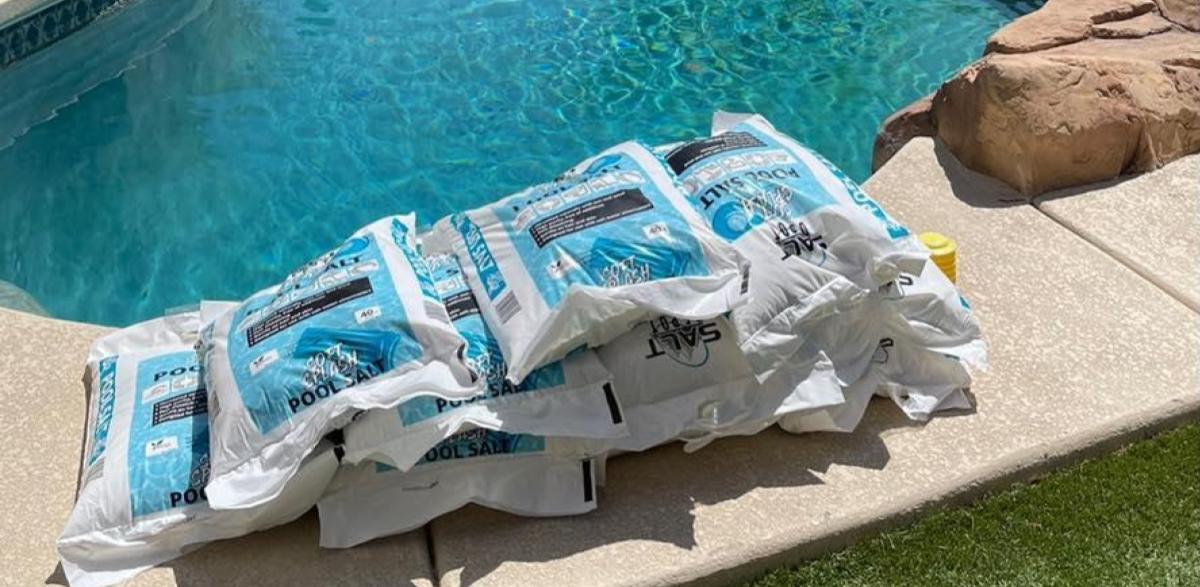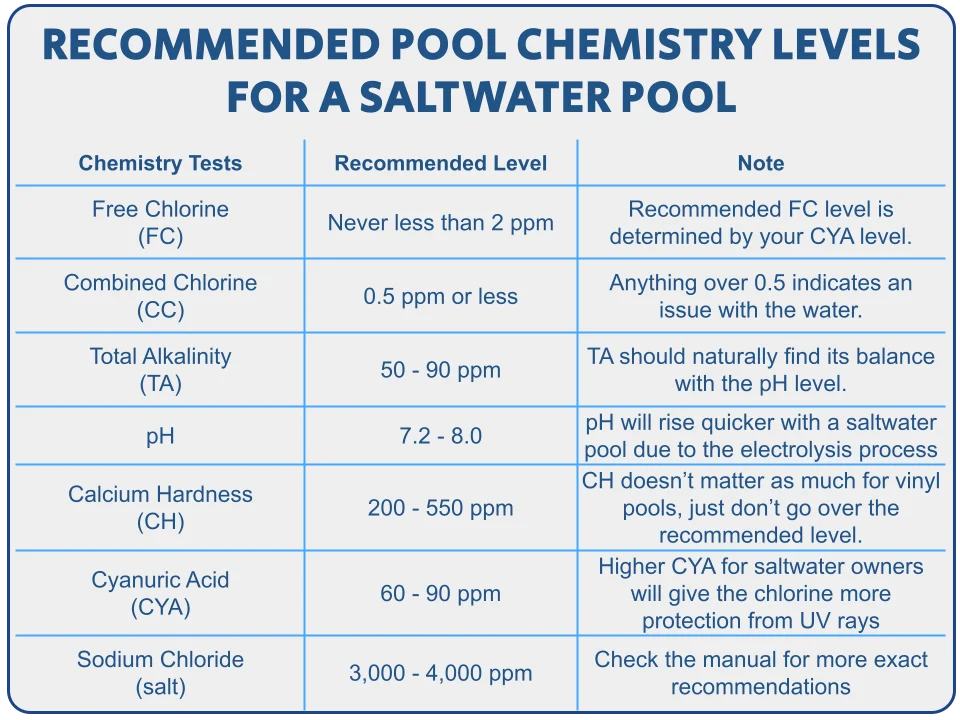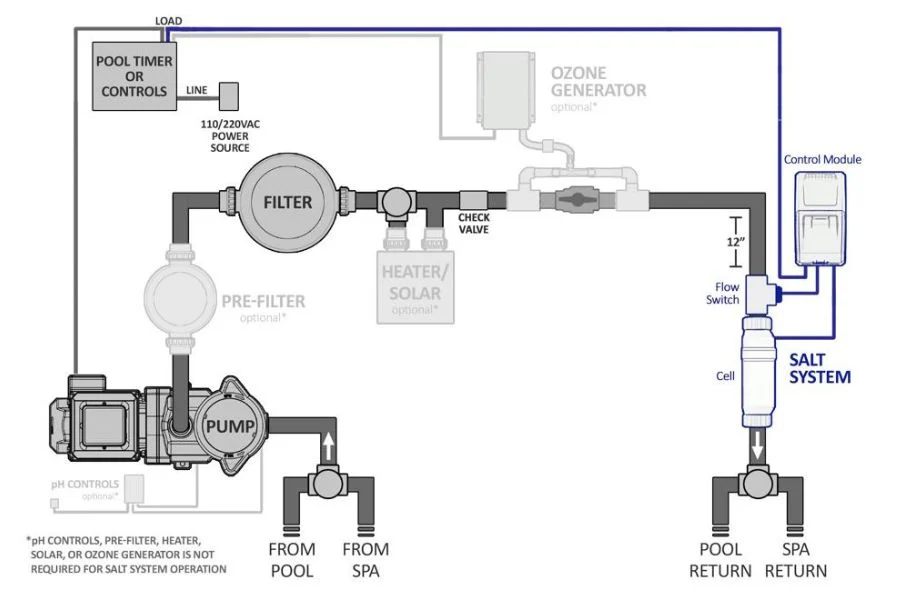How to Convert Your Pool to Saltwater: Follow This Basic Guide

Thinking about converting to a saltwater pool? Surprisingly, setting up a saltwater system isn’t too difficult.
There isn’t that much of a difference between a saltwater pool and a “typical” chlorine pool. It’s still chlorine, and the maintenance is about 90% the same.
Let’s break down all aspects of a change, including cost differences and installation.
Cost of Converting a Pool to Saltwater
In general, a saltwater pool is less expensive to maintain over a period of time. However, there is initial and upfront costs to install the equipment and add the initial bags of salt.
The salt chlorine generator itself typically ranges from $800 to $2,000, depending on the brand and size of your pool. And while it is DIY-friendly, you will need to cut your plumbing and wire it to your system.
Depending on how much salt is needed, prices could range from $100-$500.
Ongoing costs are pretty modest. You may need to add some salt throughout the swim season, but not nearly as much as the initial startup.
The generator cell will also eventually need to be replaced, typically every 3 to 7 years, and replacement costs run from $300 to $700.
That said, many pool owners find that the system pays for itself within a few seasons, especially with the rising costs of chlorine.
Converting Your Pool From Chlorine to Saltwater
The actual process is straightforward when broken down into clear steps. You need to get the pool water ready for salt, install the generator, and maintain it throughout the season. Easy peasy!
Test and Balance the Water
As mentioned above, a saltwater pool isn’t that much different than a pool that gets chlorine added manually. The water chemistry isn’t that much different either.

The one main difference is the cyanuric acid (CYA) levels. It’s recommended to go a little higher for a saltwater pool. Since the generator will constantly add chlorine (at the very least, add more than manual chlorine additions), the CYA can be raised to offer more protection from UV ray degradation.
Most major brands will have a higher range in their manuals.
The process of converting salt to chlorine tends to cause the pH to drift upward over time quicker than normal. Keeping an eye on these drifts and having some muriatic acid handy at all times is recommended.
Add The Necessary Amount of Salt
A recommended range for salt is 3,000 – 4,000 ppm, although your generator’s manual will have a more precise recommendation. Typically, it should fall into that range.
Before adding, run a salt test to know how much is currently in the water. You’d be surprised how much is in there. Most chemicals, especially liquid chlorine, have sodium chloride as an ingredient.
The salt you use should be over 99% pure sodium chloride. Other additions can reduce the lifespan of the generator.
Once you know how much salt is in the pool and the ppm amount you still need, use our salt calculator to see how many bags are needed.
Installing the Saltwater Generator
The saltwater generator you choose goes a long way to determining how well it can function. The general rule of thumb is to use a generator cell that is 2x the volume of the pool, or 1.5x at a minimum. For example, if you have a 20,000-gallon pool, a cell that is rated for 40,000 is ideal.
Oversizing your cell means it won’t have to work nearly as hard to generate the chlorine needed. Rather than working at 80-100%, it can be just as effective at 20 – 40%. This can extend its lifespan significantly.
Installation can be a DIY project if you’re comfortable with basic plumbing and electrical work, but many pool owners choose to hire a professional, especially for the electrical hookup.
The generator is typically plumbed into your return line, after your pool’s filter and heater. If you are putting it in yourself, use the manual for exact instructions.

Continue Routine Pool Maintenance
Once you have it up and running, general maintenance isn’t really any different than what you’re used to. The main difference is checking the generator periodically for scale buildup or performance issues. Again, the manual will have general directions for cleaning or troubleshooting guides for any issues
You’ll want to keep an eye on the salt level throughout the season and add when necessary. It’s recommended to get a tester for salt.
Drop test for sodium chloride (salt) pool owners.
Testing strips that include sodium chloride are OK to use as well. Salt tests don’t need to be as accurate as other chemistry parameters.
Otherwise, keeping the pool balanced and clean is pretty much the same.
Is it Time to Swim Yet?
Congratulations on not having to lug around gallons or boxes of chlorine everywhere!
Changing to a saltwater pool can be a smooth and satisfying upgrade. While it is generally “easier” to maintain, saltwater pools still need the maintenance and care as any other pool.
Once you’ve made the choice and set it up, I don’t think you’ll ever go back!

